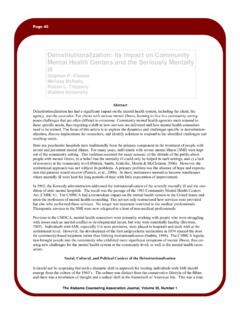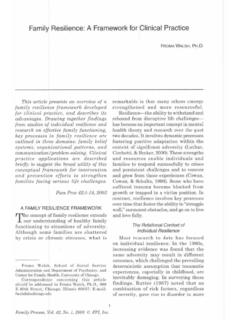Transcription of SEXUALITY EDUCATION: WHAT IS ITS IMPACT?
1 SEXUALITY education delivered within a safe and enabling learning environ-ment and alongside access to health services has a positive and life-long effect on the health and well-being of young people. Studies in several European coun-tries have shown that the introduction of long-term national SEXUALITY edu-cation programmes has led to hard outcomes , as shown in Table 1:IMPACT OF GOOD QUALITY SEXUALITY education ON THE HEALTH AND WELL-BEING OF CHILDREN AND YOUNG PEOPLE Reduction in teenage pregnancies and abortions Decrease in sexually transmitted infections (STIs) among young people aged 15 24 years3, 4 Decrease in HIV infections among young people aged 15 24 years4 Decrease in sexual abuse5, 6 Decrease in homophobia5, 6 Table 1: Hard outcomes of good quality SEXUALITY educationPolicy brief No.
2 2 SEXUALITY EDUCATIONSEXUALITY education : WHAT IS ITS IMPACT? This policy brief provides an overview of the impact of good quality SEXUALITY education on the health and well-being of children and young people. The examples in this brief are taken from Europe and Central Asia but they are also relevant to countries outside of these education is teaching about the cognitive, emotional, social, inter-active and physical aspects of sexual-ity. SEXUALITY education does not encourage children and young peo-ple to have sex. In the Standards for SEXUALITY education in Europe, experts agreed that: SEXUALITY education starts early in childhood and progresses through adolescence and adulthood .
3 For children and young people, it aims at supporting and protecting sexual devel opment. It gradually equips and em powers children and young people with information, skills and positive values to understand and enjoy their SEXUALITY , have safe and fulfilling relationships and take responsibility for their own and other people s sexual health and well being. 1 SEXUALITY education lays the foundation for a safe and fulfilling passage to adulthood , by encouraging un-derstanding of emotions and feelings, teaching the principles of human re-production, exploring family and in-terpersonal relationships, learning about safety, and developing confi-dence and communication skills.
4 These can then be built upon gradual-ly, in line with the age and stage of de-velopment of the policy brief presents the available evidence describing the hard and soft aspects of SEXUALITY education . At the same time, the authors recog-nize that the impact of soft aspects of SEXUALITY education have not been sufficiently studied to IN AGE AT FIRST INTERCOURSE From 2005 to 2010 the percentage of sexually experienced 15-year-olds has remained stable in Western Euro-pean countries and increased in East-ern European , 9 However, at least four countries (Finland, Germany, Kazakhstan and the Neth-erlands) observed a decrease in the percentage of sexually experienced 11 INCREASED CONTRACEPTIVE USE AT FIRST INTERCOURSEOver the last three decades, Germany saw a significant increase in contra-ceptive use at first intercourse.
5 In 2010, 92 % of young people used some form of contraception at first inter-course, compared with only 80 % of girls and 71 % of boys in 1980 (Figure 1). Similarly, in the Netherlands, nine out of ten adolescents used contra-ceptives at first intercourse. This is not only due to SEXUALITY education , but also to national safer-sex cam-paigns, good access to reliable, af-fordable and acceptable contraception, youth-friendly services and support-ive environments. Increased condom use is particularly important as it also protects from HIV, other STIs and human papillomavirus (HPV). Figure 2 shows contraceptive use broken down by contraceptive 1: Contraceptive use at first intercourse in Germany11100806040200198080%92%71%92%201 0 Girls BoysFigure 2.
6 Contraceptive method at first intercourse in the Netherlands in 1995 and 201112, 13 Young people using no contraceptive have been excluded from this table100806040200 Girls Condom Pill or other forms of contraceptives Pill and condom Boys Condom Pill or other forms of contraceptives Pill and condom19952011 experience of some countries provides direct evidence for the positive behavioural changes that have occurred in parallel with the introduction of SEXUALITY that, by increasing confidence and strengthening skills to deal with different challenges , SEXUALITY educa -tion can empower young people to de-velop stronger and more meaningful relationships (Table 2). Social norms and gender inequality influence the expression of SEXUALITY and sexual behaviour.
7 Many young women have low levels of power or control in their sexual relationships. Young men, on the other hand, may feel pressure from their peers to fulfil male sexual stereotypes and engage in controlling or harmful behaviours. Good quality SEXUALITY education has a positive impact on attitudes7 and values and can even out the power dy-namics in intimate relationships, thus contributing to the prevention of abuse and fostering mutually respectful and consensual partnerships. Awareness of human rights Respect, acceptance, tolerance and empathy for others Gender equality Confidence and self-esteem Skills in contraceptive use Empowerment and solidarity Critical thinking Skills in negotiation, decision-making and assertiveness Parent-child communication Sexual pleasure and mutually respectful relationshipsTable 2.
8 Soft outcomes of good quality SEXUALITY educationDECLINE IN SEXUALLY TRANS-MITTED INFECTION RATES In Estonia, increased knowledge about contraception and condoms, access to youth-friendly sexual and reproduc-tive health services and a supportive policy environment are thought to be the reason for the dramatic decline in STI rates among 15 24-year-olds (Figure 4).4 DECLINE IN TEENAGE PREGNANCY RATES SEXUALITY education is thought to de-crease teenage pregnancy rates be-cause of the specific knowledge it im-parts about contraception including condoms, positive attitudes and inten-tion to use contraception, self-efficacy in using contraception, negotiation skills when a partner refuses to use a condom, ability to seek contraceptive services and counselling, and more.
9 In Finland, school-based SEXUALITY education and sexual and reproduc-tive health services for young people were introduced in 1990, leading to an immediate decrease in teenage preg-nancy rates. However, owing to budget constraints, both pro-grammes were drastically reduced in the period 1998 2006. This had an im-mediate impact on abortion and birth rates among 15 19 year old girls. The rates decreased again after the rein-troduction of SEXUALITY education and youth-specific health services in 2006 (Figure 3).3 Figure 4: Decline in registered cases of three STIs (Chlamydia, gonorrhoea and syphilis), Estonia, 2001 2009 Data source: Murd, M. and A. Trummal. 2010. HIV ja seotud nakkused arvudes 2009.
10 Aasta seisuga [HIV and related infections in numbers in 2009]. Tallinn, National Institute for Health 19 years20 24 years20001800160014001200100080060040020 0020052003200720022006200420082009 STI casesFigure 3: Abortions and deliveries in 15 19-year-old girls (per 1000), Finland, 1975 2010 Abortions Deliveries302520151050750395910799850597 9309018004969208009006989410,7100216,48, 512,127,5 SEXUALITY education and health services developedSexuality education and health services were reducedSexuality education developed againREFERENCES 1. WHO Regional Office for Europe and BZgA. 2010. Standards for SEXUALITY education in Europe: A framework for policy makers, education and health authorities and specialists.














